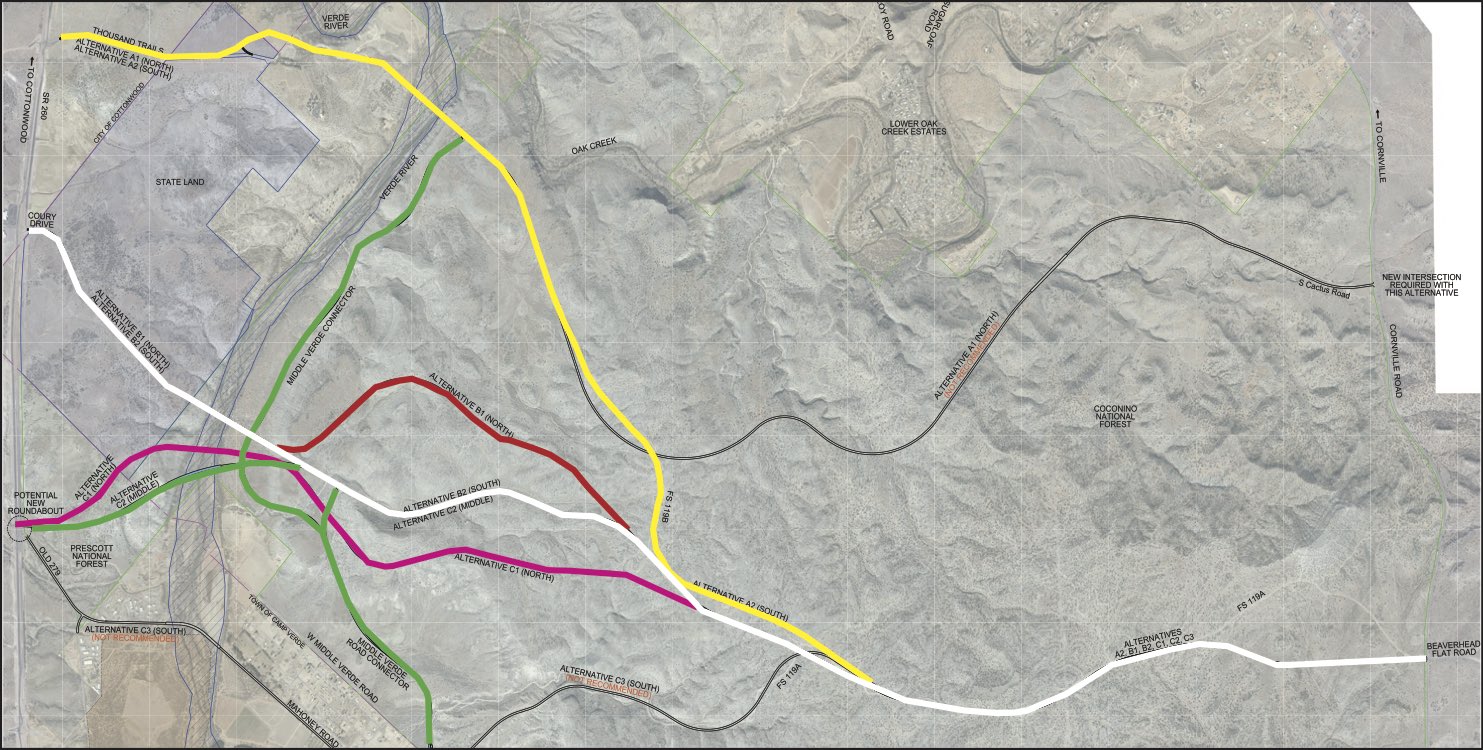
In December, Yavapai County was awarded a grant of $25 million in order to build a new road connecting State Route 260 with Cornville Road, including a new bridge over the Verde River. The whole project has been dubbed Verde Connect. For months, local municipalities, members of the public and county officialshave discussed the potential transportation expansion. But with the planning still in its early stages, those conversations have mostly dealt in hypotheticals, without any clear idea of where exactly the road would go.
On June 4, Verde Connect released seven potential routes for the new road, along with pluses and minuses of each connection. The project is still considering the “No Build” plan, where a new road would not be constructed but improvements in the area would continue.
Verde Connect is holding two public hearings this week to discuss the route options: First on Tuesday, June 11, at 6 p.m. at the Cottonwood Recreation Center, then on Wednesday, June 12, at 6 p.m. at the Camp Verde Schools Multi- Use Complex.
The potential routes are grouped into A, B and C, based on their point of origin on State Route 260. A1 and A2 would meet 260 at the roundabout by Thousand Trails Road, across from Camino Real. B1 and B2 would travel east from the roundabout at Coury Drive, on the other side of 260 from Jones Ford. Routes C1, C2 and C3 would stem out from the intersection of Old Highway 279 and State Route 260, potentially including a new roundabout as well.
All of the routes except for A1 would meet Cornville Road at the intersection of Beaverhead Flats road, connecting with some existing parts of Forest 119A Road. A1 would connect to Cornville Road farther north by South Cactus Road, necessitating a new intersection. Beyond the points of connection, the potential routes differ slightly in where the bridge over Verde River would be placed.
All the routes would also include a connection to the Middle Verde area of Camp Verde, by going around the homes east of 260 to connect with Mahoney Road from the Southeast.
Groups of residents from Middle Verde in Camp Verde had already expressed opposition to the planned road, based on belief that it could ruin the rural character of Middle Verde or that it could serve as a bypass to Camp Verde businesses. Opposition has formed into two groups of activists, Save the Middle Verde and Verde Disconnect, which have each made presentations at Camp Verde Town Council meetings urging the town to oppose the project.
According to Yavapai County District 3 Supervisor Randy Garrison, the potential routes take into consideration the opposition from Middle Verde residents, avoiding private land and aiming to limit the impact on the rural area.
“At the end of the day, nobody wants to displace anybody,” Garrison said. “Nobody wants to buy a house. We don’t want to buy private land [from] people and disrupt their land. The more we can keep it on public land, the cheaper it’s going to be for us to build it, so I think that was naturally going to happen. There was a lot of talk from some of the Middle Verde people that we were going to be plowing houses and driving right through their farms and that’s just not the goal of this project. The goal is to provide a safe, easy transportation route that at least alleviates as many of the concerns and conflicts as possible.”
Though Verde Connect provided seven potential routes for the new road, the documentation recommended against two of them, A1 and C3. The analysis finds that option A1 would mean “highest cost,” “highest environmental impacts compared to other alternatives,” while providing “lower regional benefit” and impacting trail access. According to Verde Connect, C3 would mean “highest socioeconomic impact” due to potential displacement in the Middle Verde area, “lower regional benefit” and “higher construction and maintenance costs.”
The full analysis of all the routes, available at verde- connect.com, provides pros and cons for all potential routes, as well as the “No Build” alternative. The website also allows members of the public to supply their input beyond what is discussed at the public hearings this week.
“This is a public process, so we don’t have any preconceived ideas of where it’s going to go,” Garrison said. “We’re leaving it up to public to help us push it where it needs to go.”